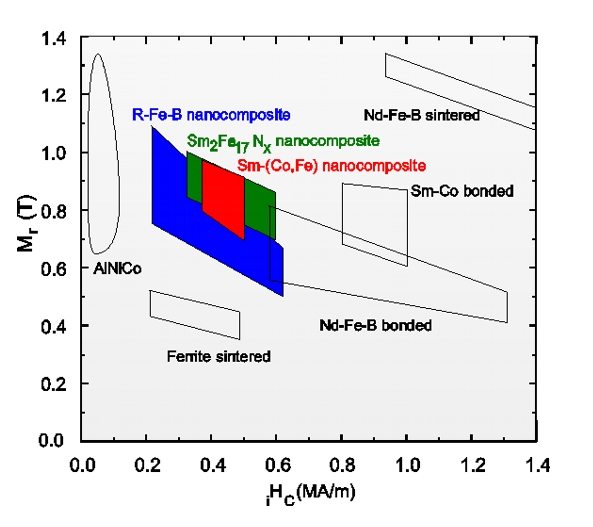Hard and soft magnetic materials
Soft magnetic materials Amorphous: The physical properties of Fe-Co-B, Fe-(B,Si) and Co-B,Si ribbons are available. The study of the new supercooled bulk amorphous materials is ongoing. Here in situ magnetization process studies at elevated temperatures can be used in order to follow the crystallization process. This is important for the thermal stability of these materials. Nanocrystalline systems:Finemet(Fe-Cu-Nb-Si-B) with variations of the Si,B and Nb content, is a system of some technical relevanz.. Fe-Zr-Cu-B is a second widely used nanocrystalline system where the magnetic properties van be varied by changing the Zr,Cu,B concentrations. Substitutions using Co is used for increasing the thermal range of application. In these composites the physical properties of the main phases is studied. Modelling the hysteresis is also one important topic. Hard magnetic materials High quality magnets based on SmCo5 on Sm2Co17 and on Nd2Fe14B are in use. These materials can be produced by a standard sintering technique but also by rapidly quenching or even mechanical alloying. The magnetization process in SmCo5 and in Nd-Fe-B is nucleation dominated whereas in Sm2Co17 based material pinning determines the magnetization process. In SmCo5 additions of Cu changes also the type of the magnetization process to pinning. Sm(Co,Cu)5 is therefore a model material with an extremely high magnetic viscosity which is a topic of interest. Also hard magnetic nanocrystalline materials were developed. In hard magnetic nanocrystalline materials a remanence enhancement was found because the magnetic exchange length is comparable to the grain size. Exchange coupled hard magnetic materials can be divided into single phased materials and into nanocomposites. The origin of exchange coupling as well as measuring and modelling the magnetization process is one of the main topics. Physics of new ferrites: new compounds such as La-ferrites are investigated. As experiments are used: temperature dependence of hysteresis loop (from 4.2K up to 800K), magnetostriction, magnetocrystalline anisotropy, magnetic viscosity, modelling. Cooperations: IFW (Dresden), VAC (Hanau), Ugimag (France), Univ. Sheffield, Univ. Havanna ... |
Fig.1: Comparison of the magnetic properties for different hard magnetic materials |
Contact: R. Grössinger |


